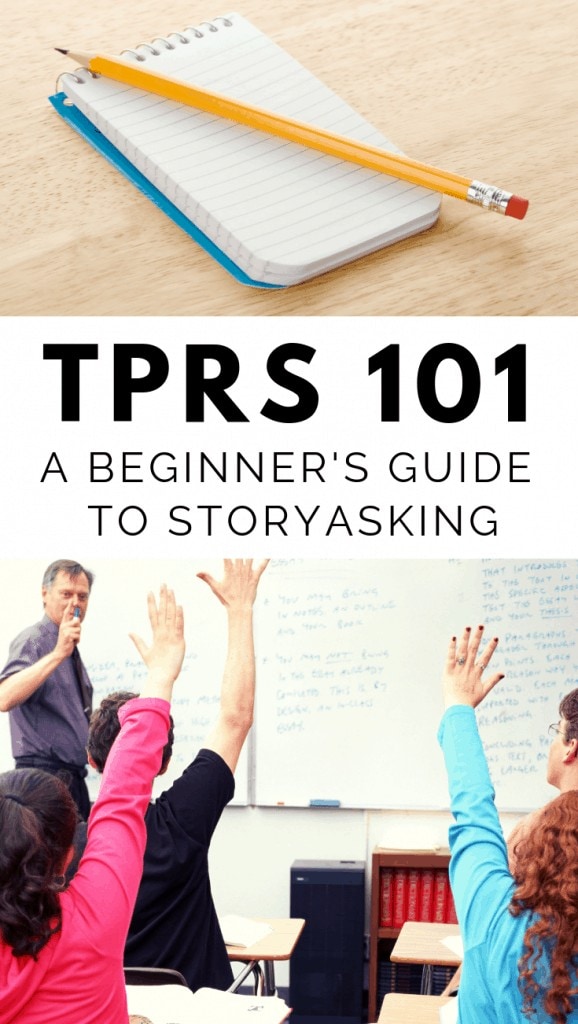TPRS 101: A Guide to Storytelling in the Spanish Classroom
Inside: A look at the basics of TPRS, a language teaching method for providing comprehensible input when teaching foreign languages.
TPRS has been a hot-button acronym for language teachers. For many, it’s a wonderful tool. Others feel it’s only for extroverted teachers who can think up bizarre stories on the spot.
But wait! TPRS is a broad, flexible method. TPRS lessons can be the basis of your curriculum, or something you do occasionally.
In this post, I’d like to clear up some of the myths surrounding TPRS, lay out the basic steps and adaptations, and then provide some video examples of TPRS from everyday teachers.
Teaching Proficiency through Reading and Storytelling was one of the first CI-based techniques I learned. The first attempts were terrible flops (I mean awful), but I stuck with it and I’m so glad I did.
Contents:
1. TPRS in Nutshell
2. TPRS Myths
3. The 3 Steps of TPRS
4. The Origins of TPRS
5. Demos and Videos of TPRS Teachers
Even as I’ve put many other tools in my CI box, the skills from TPRS are foundational to other strategies like Movie Talk, Persona Especial, and others. It’s been transformative in my teaching and I love how it helps me boost my time in the target language and my students’ fluency.

TPRS in a Nutshell
TPRS (Teaching Proficiency through Reading and Storytelling) is a foreign language teaching method that was developed by Blaine Ray in the 1990s. It’s based on the idea that students acquire language best through interactive and personalized comprehensible input.
The method uses storytelling to build a narrative in the target language, based on interaction between the teacher and students. This is usually through 3 main steps (and can take more than one class):
1. Introduce New Vocabulary
The teacher introduces a small set of new phrases that will be repeated often throughout the story.
2. Co-create a Story
The teacher guides the class in creating a story, asking questions from the questions to decide on the details. This may mean creating the main characters, the setting, the problem, and main events.
3. Write and Read the Story
When the story is complete, it can be turned into a text for class reading. The reading provides even more exposure in context to the new vocabulary.
This technique has been shown to be effective in language acquisition, as it allows students to engage with the target language in a fun and creative way. It’s intended to create a low-stress and enjoyable language-learning environment.
TPRS Myths
First, let’s talk about a few common TPRS myths:
- TPRS = CI. Remember that Comprehensible Input is a thing: messages students understand. TPRS is only of many ways to providing quality CI.
- TPRS = Crazy and Weird. Truth be told, many teachers do rely on the weird element to make their stories interesting. But it’s not a rule that stories *must* be strange!
- Being a CI Teacher = Doing TPRS Everyday. You can do it everyday, if you want to. You can never do it, and still be an effective CI teacher.
- TPRS = No grammar. It’s true that TPRS avoids explicitly teaching grammar rules. However, students are internalizing grammatical structures as they go.
Now that those are out of the way, let’s dive into the actual of TPRS.

The 3 Steps of TPRS
As noted above, TPRS is generally divided into three main steps:
I am just going to provide a basic overview of each step. There is so much more to say about each one, so if you would like a full, detailed account of each one with examples, this document from the ever-generous Bryce Hedstrom will help you immensely.
tep 1: Introduce the New Targets and Establish Meaning
Traditional TPRS uses a targeted approach: the teacher selects specific new words or language structures (usually three) and centers the story on those targets.
Before starting the story, the teacher introduces the targets (usually by providing a direct written translation in English). All the students should be clear on exactly what the targets mean.
Then, the teacher spends time establishing meaning, in order to provide meaningful repetitions of the targets. This can involve the following options:
- Create gestures (as seen in the original version of TPR-Storytelling): spend time doing TPR with the phrases. Adding this physical movement can help those new words stick.
- PQA: Personalized Questions and Answers that the teacher asks the students, focusing on the targets. (If the target is “listens to music” the teacher can ask what music they like, when they listen to music, etc.)
- Showing memes or pictures that illustrate the targets, and discussing them.
Step 2: Co-create a Story Between the Teacher and the Class
Even though TPRS is often called a storytelling method, this step is often referred to as story-asking because it is really a collaboration between the class and the teacher.
The traditional storyasking process often looks like this:
- Create the main character and setting, and describe both.
- Create the main problem or conflict of the story (often that the main character wants something).
- Create three scenarios in which the main character tries to fix the problem (often the first two attempts are unsuccessful and the third resolves the conflict).
- End the story and describe how the character feels.
Either way, the teacher is responsible to guide the story process, which is all oral at this point. The teacher is actively soliciting help from the class to create the story, while adjusting questions to stay comprehensible (they can be open-ended, yes or no, or either/or).
If you want to see what the teacher-class exchange might look like, scroll about halfway down this article from Carol Gaab on story-asking.
As the story progresses, the teacher will encourage the students to add details, pause and check in with comprehension questions, and circle. At all times, the teacher is seeking to stay 100% comprehensible, writing down any “out of bounds” language that may get used in the story creation process.
Here are some variations on storyasking together:
- Use student actors: you can select certain students to act out the characters as you narrate the action. Sometimes the teacher will talk directly to the actors and solicit information from there (instead of just “la chica va a la tienda,” you can ask directly “¿Vas a la tienda o a la escuela?“)
- Use props or visuals in the story.
- Some teachers, especially those getting started, already have a rough outline in mind or even a full script, while other teachers might leave the storyline wide open.
- In Blaine Ray demos, he encourages his classes to respond with an enthusiastic “oooh” as he describes certain details. Some teachers do this, and some don’t.
- Capitalize on the bizarre: often, stories get “crazy” or “weird” elements added to them to add interest and make it memorable to students.
Step 3: Write and Read the Story
Here we come to the “r” of TPRS: reading. As a newbie, this was a step I didn’t always follow up on, and now I see that was a big mistake!
Reading is perhaps the most crucial factor in our students gaining proficiency in their new language:
“People acquiring a second language have the best chance for success through reading.” – Stephen Krashen
Many teacher do a reading the next day, when they’ve had the chance to type up the story. Others assign the job of transcribing the story to a certain student (perhaps a heritage student) during story-asking.
Some language teachers even write a summary of the story with the whole class, while projecting onto the screen for everyone to see. This gives the students the chance to watch the writing process and the teacher can review and elicit details in real time while she writes.
With TPRS in its traditional form, the class would always read the story and translate it sentence by sentence. (If you are unsure of this practice or the use of L1 in the classroom, the end of the this article from Carol Gabb is helpful.) Reading the story together is often the time when a teacher can do “pop-up grammar,” a very brief in-context explanation or note on a certain grammar point.
One problem with simply typing up the story and stopping there, of course, is that the students already know the story and can anticipate the details. Many teachers provide alternate versions for reading to maintain suspense. This could be the original version of the story you wrote before the class created their own, or swapping stories between classes.
Either way, reading is absolutely a pillar in TPRS classroom. As it has evolved, here are some variations for reading you’ll find in many classrooms:
- Readings that use similar targets: this could be non-fiction, lyrics from songs, another story, or anything related that is comprehensible to the students.
- FVR or SSR (Free Voluntary Reading or Self-Selected Reading), in which the students have time to select texts/novels/books to read on their own.
- Whole-class novel units, in which the entire class works through a level-appropriate novel together.
Blaine Ray and TPRS®
Now that you know all about it, let’s take a look at its origins of this methodology.
TPRS was first created by Blaine Ray, a Spanish teacher in the 1990s who was influenced by the TPR Method (Total Physical Response) — hence the original name of “Total Physical Response Storytelling.” Ray was looking for a way to make language instruction more engaging and efficient for his students.
“Ray had experienced success in using Total Physical Response to teach Spanish, but sought ways of helping his students move beyond TPR commands to more narrative and descriptive uses of language.”
Blaine Ray was also following Stephen Krashen’s research into Second Language Acquisition, and the input hypothesis for language learners.
The method is based on the principle that the best way to learn a language is through meaningful, enjoyable and repetitive experiences, rather than memorization of grammar rules and vocabulary lists.
Krashen describes the power of reading and TPR storytelling this way:
“Language acquisition proceeds best when the input is not just comprehensible, but really interesting, even compelling; so interesting that you forget you are listening to or reading another language.”
From these SLA principles, Blaine Ray began to develop his storytelling method that provided interesting language to students in context, with a healthy dose of repetition for long-term acquisition.
TPRS DEMOS AND VIDEOS
Sometimes the best thing is to see a strategy in action! Here are some great videos from everyday teachers demonstrating storyasking/storytelling in their classrooms.
STORYTELLING WITH ADRIANA RAMÍREZ:
“In these videos I am teaching first year Spanish students. These students have never been exposed to Spanish before. In our school, we work on the semester system, and this is week 10 into the 18-week semester.”
COLLABORATIVE STORYTELLING WITH ERIC HERMAN:
“A 13.5 minute video summary of a 7th grade “Students & Stories in Spanish” class.
My* “method” is . . . – A comprehension-based, communicative approach – unplanned, non-targeted, sheltered vocabulary – collaborative storytelling activity, among other activities.”
STORY CREATION WITH ALINA FILIPESCU:
TPRS WITH SARAH BRECKLEY:
STORYASKING WITH GRANT BOULANGER:
“This video shows students retelling a narrative that was collaboratively created. The teacher used a basic story script and invited students to add details to the story with the purpose of allowing students to self-select vocabulary and self-direct the story. These are level 1 students.”
MICHELE WHALEY DEMOS TPRS IN RUSSIAN:
“Anchorage School District’s Michele Whaley teaches Russian language using the TPR Storytelling method. This is the full 1 hour class session.”
TPRS WITH MARTINA BEX:
I would love to hear your experiences with TPRS in the language classroom. Share in the comments below!







Fabuloso
These videos are so helpful! I just need help with the 1st class of TPRS w/3rd and 4th grade children NEW to Spanish. Any videos or tips for the first day and week of classes? Thank you so much!
Vicki
[email protected].